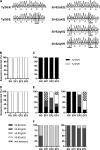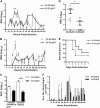The effect of the PB2 mutation 627K on highly pathogenic H5N1 avian influenza virus is dependent on the virus lineage
- PMID: 23843645
- PMCID: PMC3753988
- DOI: 10.1128/JVI.01399-13
The effect of the PB2 mutation 627K on highly pathogenic H5N1 avian influenza virus is dependent on the virus lineage
Abstract
Clade 2.2 Eurasian-lineage H5N1 highly pathogenic avian influenza viruses (HPAIVs) were first detected in Qinghai Lake, China, in 2005 and subsequently spread through Asia, Europe, and Africa. Importantly, these viruses carried a lysine at amino acid position 627 of the PB2 protein (PB2 627K), a known mammalian adaptation motif. Previous avian influenza virus isolates have carried glutamic acid in this position (PB2 627E), commonly described to restrict virus polymerase function in the mammalian host. We sought to examine the effect of PB2 627K on viral maintenance in the avian reservoir. Viruses constructed by reverse genetics were engineered to contain converse PB2 627K/E mutations in a Eurasian H5N1 virus (A/turkey/Turkey/5/2005 [Ty/05]) and, for comparison, a historical pre-Asian H5N1 HPAIV that naturally bears PB2 627E (A/turkey/England/50-92/1991 [50-92]). The 50-92 PB2 627K was genetically unstable during virus propagation, resulting in reversion to PB2 627E or the accumulation of the additional mutation PB2 628R and/or a synonymous mutation from an A to a G nucleotide at nucleotide position 1869 (PB2 A1869G). Intriguingly, PB2 628R and/or A1869G appeared to improve the genetic stability of 50-92 PB2 627K. However, the replication of 50-92 PB2 627K in conjunction with these stabilizing mutations was significantly restricted in experimentally infected chickens, where reversion to PB2 627E occurred. In contrast, no significant effects on viral fitness were observed for Ty/05 PB2 627E or 627K in in vitro or in vivo experiments. Our observations suggest that PB2 627K is supported in Eurasian-lineage viruses; in contrast, PB2 627K carries a significant fitness cost in the historical pre-Asian 50-92 virus.
Figures








References
-
- Alexander D, Brown I. 2009. History of highly pathogenic avian influenza. Rev. Sci. Tech. 28:19–38 - PubMed
-
- Bosch FX, Orlich M, Klenk HD, Rott R. 1979. The structure of the hemagglutinin, a determinant for the pathogenicity of influenza viruses. Virology 95:197–207 - PubMed
-
- Steinhauer DA. 1999. Role of hemagglutinin cleavage for the pathogenicity of influenza virus. Virology 258:1–20 - PubMed
-
- Alexander DJ. 2007. An overview of the epidemiology of avian influenza. Vaccine 25:5637–5644 - PubMed
Publication types
MeSH terms
Substances
Grants and funding
LinkOut - more resources
Full Text Sources
Other Literature Sources
Medical

